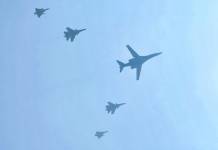Although Russia and Ukraine have adopted various deception tactics to defend against enemy attacks, a recent viral video has leveled up Ukraine’s game in a way that its foes couldn’t have fathomed.
MUST READ: In Rarest Of Rare Events, US, China, Russia Join Hands For ‘Komodo’ Naval Drills In The Indo-Pacific
In a video tweeted by EurAsian Times, a harmless and unsuspecting house in a secluded lush green field with wild grass is seen moving with agility, drawing a host of mixed responses from media watchers and netizens.
The video was reportedly shot somewhere in Bakhmut and was believed to be a tank or some other Ukrainian combat vehicle camouflaged to look like a house. The 15-second footage was shared widely. The development comes even as a Ukrainian counteroffensive is underway.
Posting the video on Twitter, user ‘OSINTtechnical’ said in a caption, “Imagine the Russian grunts reaction when they see an entire traditional Ukrainian village house start driving across a field outside Bakhmut.”
Some netizens and regular military watchers wondered about a scenario where a whole battalion of tanks camouflaged as houses approached Russian positions, giving the impression that an entire hamlet had come to attack the Russians. “Imagine 75 combat dachas in battalion assault formation coming to you,” said one user on Twitter.
Imagine the Russian grunts reaction when they see an entire traditional Ukrainian village house start driving across a field outside Bakhmut. pic.twitter.com/GmJI4QB1CQ
— OSINTtechnical (@Osinttechnical) June 5, 2023
After the first clip went viral, others also made their way to the internet, showing combat vehicles dressed like small houses moving on unidentified pathways.
Others, however, questioned the clip’s veracity as it garnered various reactions, from awe to mockery to even charges of a purported “war crime” since international law forbids disguising military equipment and vehicles as civilian infrastructure.
The clip comes at an opportune moment when Ukrainian forces have reportedly mobilized their tanks (including the newly acquired Leopard-2s) and Infantry Fighting Vehicles (IFVs) for their counteroffensive against Russian troops. Some visuals have been posted showing close-range tank battles between the two sides.
In a video published recently, the Russians claimed to have struck a Ukrainian Leopard-2 tank, which later turned out to be a tractor. However, on June 8, it was finally confirmed that Ukraine lost at least one Leopard-2A4 MBT for the first time in the ongoing conflict.
Against that backdrop and amid a fast-escalating counteroffensive, it makes sense why the Ukrainians have resorted to camouflaging their combat vehicles into houses. Moreover, as noted by EurAsian Times in an analysis, the Russians have the defender’s advantage, which further exposes Ukraine’s war machines to enemy fire.
Moreover, the creativity shown by the Ukrainians in making tanks look like unsuspicious houses have been received with bewilderment. “I thought that the creativity of the Ukrainians in the art of camouflage would not shock me anymore…” a tweet from Intermarium 24 said June 5, receiving more than 1.5 million views.
However, despite the creativity seen now, the ingenuity and technological innovation on the battlefield have been abundant throughout the 15-month conflict between Ukraine and Russia. EurAsian had reported many of them earlier.
Innovation In The Ukraine War
A crucial battle strategy is to trick your adversaries. Throughout history, military strategy has included dummies, including fake soldiers, artillery, tanks, and aircraft. Both combatants have extensively used “dummies” to confuse the enemy in the ongoing war.
-
Dummies, Decoys, And Mock Ups
For instance, several reports emerged of Ukraine using wooden structures or inflatables of their “game-changing” weapon HIMARS, and other combat vehicles to confuse the Russians.
Media reports had earlier revealed that Ukraine had positioned a fleet of wooden HIMARS to expose Russian weapon locations, causing the Russian military to waste its limited supply of precision missiles. The HIMARS replicas are constructed of wood, yet they are sufficiently similar to the originals.
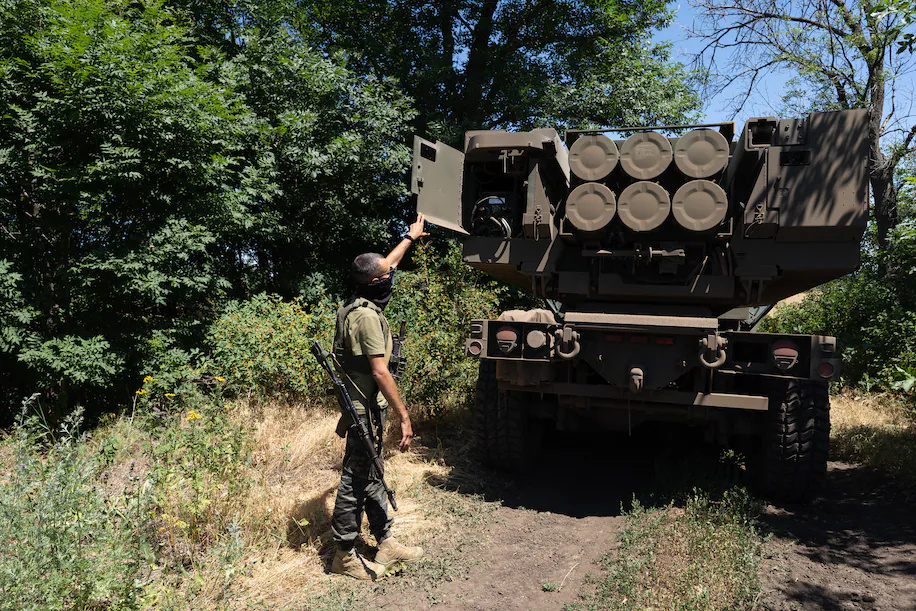
The Russians took the bait and claimed to have destroyed several HIMARS last year. However, a recent video posted by the Ukrainian MoD revealed that all 18 of the HIMARS received by Kyiv from the United States were intact and stored in Soviet-era nuclear bunkers to shield them from missile or UAV attacks.
This again brought attention to Ukraine’s large-scale use of dummies that the Russians destroyed. Besides wooden structures, the Ukrainians have also been using inflatables of HIMARS produced and supplied by a Czech company, as reported by EurAsian Times.
?? The Czechs came up with inflatable dummies of MLRS HIMARS for the AFU ??
APU: Czechs, will you give us HIMARS?
Czech Republic: We have something better, we will send you HIMARS inflatables!LoL pic.twitter.com/YsEJZu7L7w
— Black Diamond (@blackdiammon) February 22, 2023
Months before the Russian Crimean Bridge was allegedly attacked by the Ukrainians, the Ukraine MoD posted a “floating HIMARS” video on Twitter, pointing toward the bridge and issuing a covert warning to the Russians. At the time, military analysts had identified it as an inflatable.
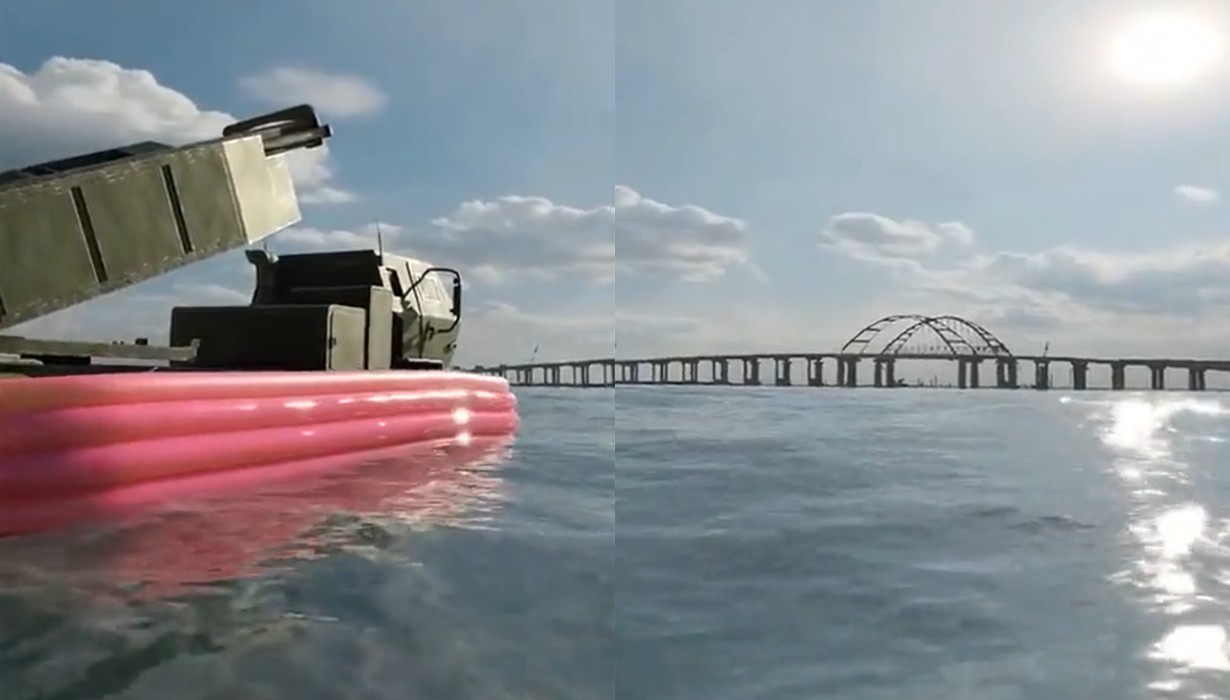
On its part, Russia is also known to have made concerted efforts to use inflatable decoys to outsmart the Ukrainian military. Previous media reports and several images and videos that surfaced on the internet suggested that Russia was using mock-ups of anti-aircraft missile systems on the front.
The spokesperson of the Ukrainian Air Force earlier said, “It must be admitted that Russians brought in a very large amount of such “hardware” such as the Buk-M1, Buk-M2, Tor, Pantsyr, S-300, and S-400 systems.”
-
Camouflaging
Since military vehicles and heavy combat systems can easily become sitting ducks for UAVs hovering in the air, hunting their targets, both sides have camouflaged their weapon systems with various traditional and modern innovative materials.
Visuals uploaded on social media have indicated that Ukraine began camouflaging its heavy Main Battle Tanks (MBTs), even mobile weapons behind wire cages or camouflage netting that snares drones before they reach their intended target.
This was done specifically to thwart attacks by Russia’s Lancet-3 loitering munitions that always remain on the prowl to take out Kyiv’s hardware on the frontlines.
Besides using nets and wires, Ukraine has also used “digital camouflaging” to confuse Russian UAVs. In April this year, pictures of at least one Bradley Infantry Fighting Vehicle in an eminently Ukrainian pixelated “digital” camouflage pattern and another in all-green overall surfaced and added to the list of Ukrainian ingenuity.
Bradley IFVs try on a new outfit. pic.twitter.com/OzMAF2d5tV
— Defense of Ukraine (@DefenceU) April 17, 2023
Ukrainian armored and unarmored vehicles frequently have camouflage patterns with pixelated sections in various greens, tans, and black over a base coat of green. Since February 2022, when Russia declared an all-out war on the nation, other vehicles that the Ukrainian military has received as an aid have been spotted with pixelated graphics.
On its part, Russia started using advanced camouflaging early on in the conflict. To hide tanks and other armored equipment, Russian troops in Ukraine have resorted to deploying tree branches, straws, and even large expanses of carpeting to evade discovery and attack.
Stung by massive losses, Russian forces started employing a camouflage that reportedly decreased the visibility of combat vehicles in the infrared and radar spectra. This was in addition to more traditional camouflage paints and nets.
“This camouflage is a synthetic material placed on top of the equipment in the form of cases or covers. The material decreased the level of thermal radiation, for instance, of a tank several times so that it almost merges the background surface. In the radar range, the distance of vehicle detection drops substantially,” an informed source said in April 2022.
-
Wooden Logs, Bamboo, And Cope Cages
Deception and protection have been an overarching theme among the Russian and Ukrainian troops in the ongoing conflict.
Russian troops have ‘up-armored’ tanks with various materials to fend off missile attacks and shield them from gunfire and missiles. Ukrainians call them the “Artisanal Army” because they prefer conventional protective gear.
Early into the conflict last year, the Russian military trucks attracted attention and curiosity from bystanders when they looked to be armed with wooden logs and scrap metal plates.
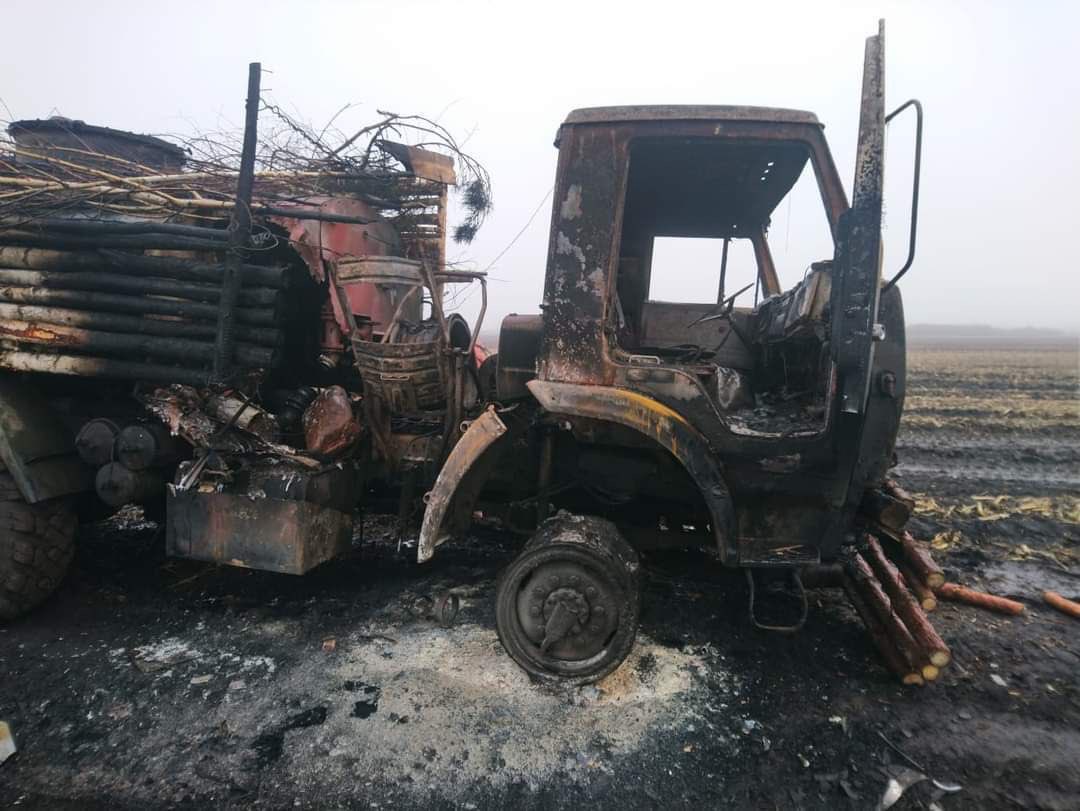
Previously, Russian armor upgrades included wooden boards and scrap metal that were observed mounted to the front of Russian KamAZ trucks. It was then assumed that the logs were designed to shelter the vehicles’ vulnerable radiators from small-arms fire because they were acquired from the same forests the trucks were passing through.
The Russian forces also adopted make-shift metal cages to the tops of their tanks in an apparent attempt to defend against Javelin and other anti-tank missiles. The use of cope cages has been rampant in the ongoing conflict, especially in Russia.
Numerous tanks, MLRS, and other armored vehicles owned by Russia are all vulnerable to attack by Ukrainian infantry wielding Javelins and other anti-armor weaponry.
Before the escalation of its war in Ukraine, Russia tried to keep ahead of the situation by welding improvised slats to the top of some of its tanks. They have now become a regular sight on the battlefield.
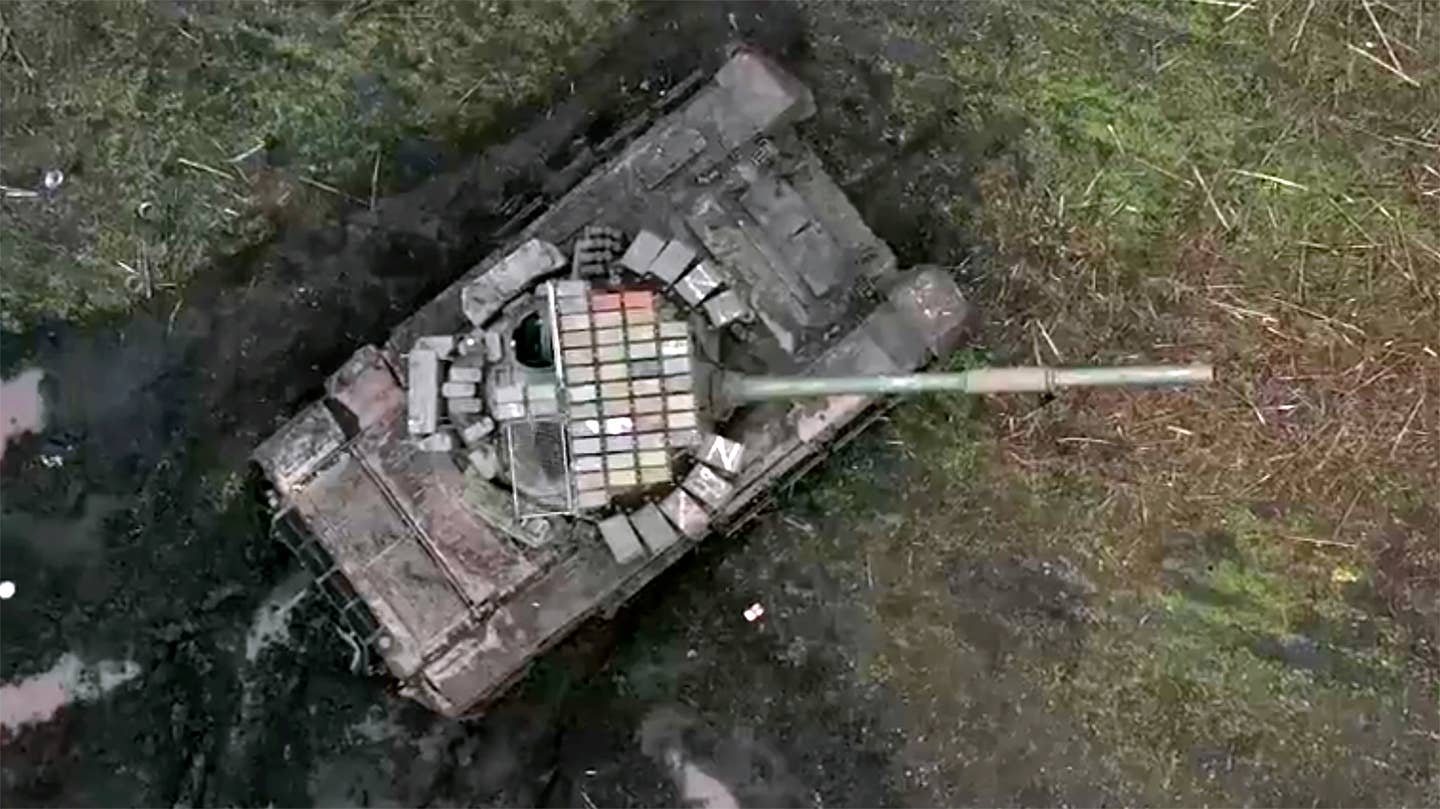
Last month, a video showed a Russian T-72B3 tank from its Western Military District tearing through the muck while wearing a “cope cage” and a layer of what appeared to be Kontakt-1 explosive reactive armor (ERA) bricks on top to protect it against Ukrainian attacks.
-
Radar Reflectors & Smokescreens
In July last year, amid threats from Ukraine to the strategic Kerch Bridge, decoy barges covered in radar reflectors and smokescreen capabilities were deployed to defend the critical bridge connecting Russia with Crimea.
Radar reflectors are constructed from several metal components that intersect to make a geometric shape that produces a potent radar reflection. They reflect the microwave radio waves emitted by radar sets back toward the antenna to deceive the enemy. Russia has extensively made use of these reflectors.
In February this year, the Ukrainian Air Force announced that Russian troops were sending balloons with corner reflectors and an airborne reconnaissance vehicle into Ukrainian airspace to spy on its air defenses.
The Russian forces have used smokescreens considerably, often caught on the backfoot due to Ukraine’s burgeoning combat capability. It involves the combination of two compounds – a liquid and a crystalline substance – which are introduced into a stream of hot gases.
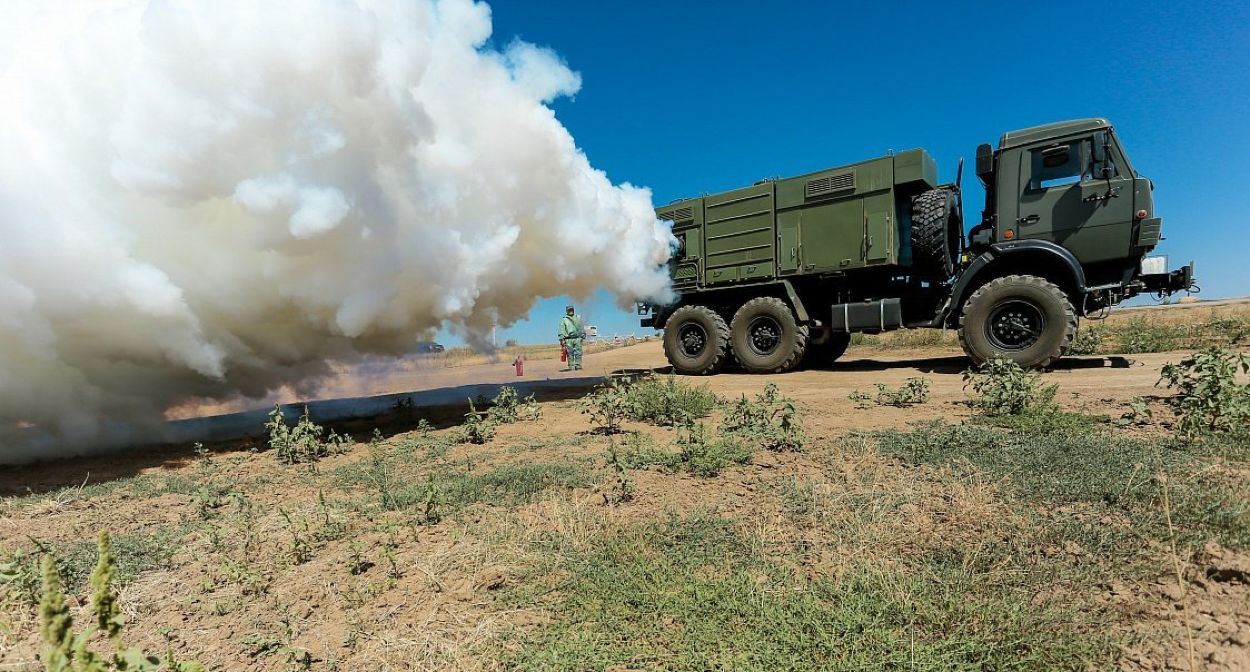
This mixture is then expelled outward, forming a dense aerosol cloud with a distinct white appearance. The primary objective of this smoke screen is to impede both visual and infrared (IR) observation, thereby offering a degree of protection against highly accurate weapons.
Although the Russia-Ukraine war has seen some of the most cutting-edge technologies being used and tested in combat, earning it the moniker of “technology war,” the unconventional and not-so-technology-related innovations have equally pulled the global attention to the intricacies and adaption in a war of attrition.
- Contact the author at sakshi.tiwari9555 (at) gmail.com
- Follow EurAsian Times on Google News

